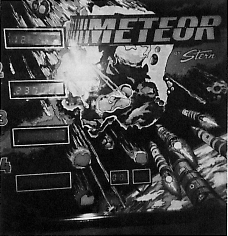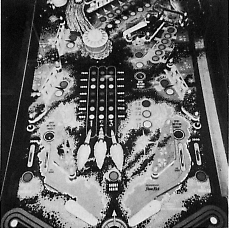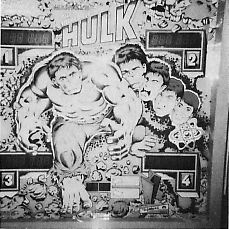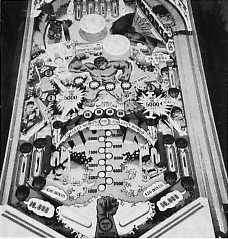Two for the ShowFor most of you, it's now Chicago and
you're reading this in your hotel room, taking a break from the
hospitality suites and trying to gear up for another day at the
Hilton, walking around the exhibits and deciding which equipment is
going to do the job for the coming months.
Others are looking at these words back in their own home town,
not able to get to the AMOA, yet acutely aware that their future
rests with what transpires over a three-day weekend.
And what's the news? Well, most of it you've had in bits and
pieces or through this column over the months, but much is unfolding
now and pointing to the future in remarkable fashion.
Things are going so smoothly from a manufacturing standpoint in
the world of pins that it's almost scary--but appearances sometimes
are deceiving. Whether you're in the Windy City in person, checking
out the stuff first hand, or trying to get an Idea from words on a
page, here Is a closer look at several of the outstanding of the
pins on display.
At Bally, the celebrity line doesn't seem to quit with the likes
of the Globetrotters ( reviewed last month), Dolly Parton ( upcoming
on these pages next month) and even a few surprises that punch some
life into an already strong line-up. Interestingly, this forerunner
of the solid-state era has taken a perceptual swing in design to
more conventional layouts and play on the board.
The in-line target feature is getting good play--it's
incorporated into three games rather close together. But even
without this innovation, Bally has continued to integrate memory
better. probably, than anyone else in the field. Sound, artwork, and
the whole cosmetic touch have been refined for this generation of
machines, and, almost assuredly, a new wave will unfold for '80.
At Game Plan the mood is happy contentment with the positive
reaction to its first conventional pin Sharpshooter, even though
plans call for more sit-downs (which, incidentally, are what
launched the company.) Two more machines are slated to follow the
run of Sharpshooter. All indications seem to say that this company
will be a tough and lasting contender in the pingame field.
Gottlieb's story is different. They have reacted well to the
changes in the industry, even if they haven't initiated too many
things. In fact, they're still the only major company which has
integrated memory from ball to ball play. Hulk, of course, is the
exception ( which we'll look at closely in the next few pages)—it's
only on extra ball play where the bonus multiplier will stay intact.
Besides this glaring omission, which has also influenced the
design parameters of recent machines, Gottlieb has entered the
celebrity fray with a few notable editions and one upcoming space
theme sure to catch more than a few eyes and quarters. But 1, for
one, am waiting for the technological breakthrough from a company
that may take a little bit longer to do things, but when they
finally get around to it, lots of folks sit up and take notice.
Stern has exploded onto the scene this year with a dizzying array
of machines as well as a startling development in drop targets which
started on Trident and carried into its newest hit, Meteor (more on
this game later).
The rap still seems to be, however, that the games wear a bit
faster than the competitors. Fortunately, the problem was less
evident on Magic, which bodes well for the games upcoming. Potential
buyers who might have been turned off will, hopefully, reconsider
the efforts of one of the major forces in the industry. Stern has
established itself, and with a few more winners, who knows what the
future holds.
Williams. What can you say about a company that's been on such an
incredible hot streak? It has its stuff together, whether it be an
imaginative wide-body or sturdy conventional model. Both artwork and
sound effects have helped the surge but the playfield designs which
have integrated unique formats, as well as memory and recall for
play continuity, probably have been the biggest factor. Perhaps the
company's most promising future ace lies in Williams' vocal
capacity--sure to be the talk of the town.
Imports? Well. as I wrote about a few issues back, the challenge
is a hard one and as you're reading this most of the viability
already will have been decided. It is going to be interesting to see
how the foreign competition copes, whether it be Zaccaria,
Playmatic, Interflip, Recel, Sonic, or any others trying to enter
into the fray.
Also, conspicuous by its absence of pins this year, has been
Atari, which fell victim to many circumstances, one of which was a
successor to the triumph of Superman. But then, '80 is going to be
an I interesting time, and who knows what the end of winter will
bring.
What is certain is that this AMOA the IAAPA, and the upcoming ATE
are going to supply the necessary showcases for a variety of
equipment that will keep a lot of people in business and keep the
business of pinball an ongoing concern. After all, we are getting
ready for a whole new decade--the beginning of the last twenty years
of the twentieth cen- tury. Pretty heavy stuff, admittedly, but just
consider that next year also marks the fiftieth year of the pinball
industry. Not bad for a nickel and .dime business where penny
arcades meant pennies and not today's quarters and dollars.
Innovation, increased costs for production, play in equipment,
higher scores, and a more sophisticated audience are just some of
the things to be aware of during this convention time. Just keep
your eyes and ears open and play everything you can, make notes and
remember the things that impressed you or stood out from the rest.
If you'd like a head start on your scouting, take a closer look
at a movie spectacular tie-in and a comic book hero turned TV star
turned pinball machine. And lest one forgets, the final tally of the
Sharpshooter poll. On with the show...
Stern's METEORA great effort, really, a great effort and
sound design from Steve Kirk make this game a winner on its own and
a sure success with the American International movie tie-in. The
artwork and the sound effects are also a big plus for what looks
like the biggest pin this company has ever made.
PLAYFIELD: The action begins with a bit of a different
alignment— the top features two pop bumpers and a sweep of three
star rollover buttons just above a row of six drop targets (
M-E-T-E-O-R). Move down to the center of the top field and there's a
lone thumper bumper and a flipper just to the right.
Further to the right is a spinner, while on the left is the first
of three drop target banks with three drop targets each. A target
just to the right of the bumper and below the top flipper finishes
off the top before one gets to a left side and right side set of
drop targets. The bottom is pure Stern with rubber-ringed posts and
wire lanes down to the flippers and a play-more post between.
ANALYSIS: The big news on Meteor is the memory drop
targets at the top with their "remote trip action." You can hit
them, go over the top rollover buttons, hit the center target when
it's at the right lit value, or go down the interior lanes to the
flippers when they're lit for spotting a letter.
Every time M-E-T-E-O-R is made the bonus multiplier increases
from 1X to 2X on up to a 7X possibility. Meteor--a great development
in pinball history and should be noted as such--Stern should be
commended for this improvement in pinball design. 
But the scoring doesn't stop there. The spinner value increases
along with M-E-T-E-O-R targets for a top of 2,200 points for each
revolution.
And then there's the drop targets and a novel use of out-hole
bonus lights integrated into the playfield graphics. The top left
side bank (twos), the bottom left side bank (ones), and the bottom
right side bank (threes) offer plenty of points and a great feature
for when the values are lined up--you've gotten one target down in
each bank, or two, or even multiples thereof that have the rockets
all with the same value--suddenly there's a chance for a 70,000
point WOW value.
And with all the scoring and shot potential with plenty of
reverses and long shots, as well as quick shots from the top flipper
to the upper targets, Meteor also offers sound effects borrowed from
the Williams' Flash school of continual auditory madness.
If all this combined weren't enough to get attention, there is an
added touch that I'd like to see everyone adopt. Before the last
ball is in play, the high score to date flashes so that a player
knows what he's shooting for, just in case he's forgotten along the
way.
Innovative touches and a package that takes advantage of the
movie makes Meteor a game to look out for.
GRAPHICS: As I have mentioned, the graphics on Meteor are
just super. It's a colorful, eye-catching theme with loads of black
orange, red, blue, yellow, green, and goodies any player or operator
would gladly notice and pay attention to. And if the movie proves to
be a hit, wait for the instant recognition.
PLAY: This is a good three-ball effort which probably
won't gain anything, except even higher scores, from an additional
two balls. For limits in extra ball areas, try a 180,000 point start
followed by 360,000 and 600,000 points. In free play areas you're
going to have to raise these levels by a good 100,000 to 120,000
points at least, depending upon the location and the caliber of the
players.
RATING ####
Gottlieb's THE INCREDIBLE HULK True visually to the comic book and not the
television characters, the game features masterful artwork for the
theme and sound effects that are a bit more rugged to fit the mood
of the game. From Marvel to Gottlieb to you comes this eye-catcher
in this company's tie-in effort. True visually to the comic book and not the
television characters, the game features masterful artwork for the
theme and sound effects that are a bit more rugged to fit the mood
of the game. From Marvel to Gottlieb to you comes this eye-catcher
in this company's tie-in effort.
PLAYFIELD: Four free-standing lanes are at the middle of
the top not butted by an rebounding rubbers, start off the action. A
bank of seven drop targets are on the right side, with two thumper
bumpers in the middle of the field and a left side wide Gottlieb
spinner finishing off the top portion.
Just below the left side spinner is a target ( two) with another
( one) below this one. In the middle is a sweep of four star
rollover buttons while the right side offers a third target ( three)
and a short rollover lane siding the plunger lane. Move down and
there's a departure for Gottlieb--two kick-back kickers are
featured, much longer than those used by Williams on such recent
games as Contact, World Cup, and the conventional wire form lanes
and flippers.
ANALYSIS: Hulk is an interesting game, with some decent
reverses and play action. There is the immediacy of getting a bonus
multiplier value off the plunger since the top lanes control the
values from left to right of 2X, 3X, 4X, and 5X.
There's also a further tie-in of features with the kick-back
kickers and drop targets denoted as A-B-C and the three targets as
one-two-three for lighting specials and extra ball value on the
field. 
But the action is also limited by the left side wide spinner
which offers good access back to the top on a precise hit but only a
weak roll down on most shots. The targets and the spacing of shots
away from the flippers make this a definite skill game without a lot
of margin for error. A countdown bonus is offered after reaching
20,000 points on the out-hole bonus, but memory is restricted to
only the bonus multiplier value ( if any) on extra ball play.
GRAPHICS: The green man is everywhere on this machine,
from the transformation on the backglass to the main spelling of the
name and primary figure on the playfield, along with green heads and
a green fist to finish off the motif. All are faithfully reproduced
from the pages of the Marvel classic and easily parlay the
popularity of the television series.
PLAY: Once again, nothing is lost on three-ball settings
with the features sustaining themselves nicely on shortened game
time ( although five-ball wouldn't be bad for heightening the
scoring. ) For extra ball locations you might want to try a 150,000
start followed by 300,000 and 500,000 points. On free play, Hulk
should be okay at levels about 50,000 to 100,000 points greater.
And on five-ball play you might even want to tack on an
additional 25,000 points, depending as always on the level of play
at the location.
RATING ###3/4
Lastly, as for the Sharpshooter poll, the results are so
encouraging, that they might even get me motivated enough to try to
design another machine.
For now, it is pleasing to hear comments that are predominantly
positive on everything from the features on the playfield to the
sound effects and the way they tie-in with the theme ( I have to
admit I'm partial to the galloping hooves of the spinner)...the
million light ( which I hope more companies will start to utilize in
the future)...and the mechanical reliability ( for which I will be
eternally grateful and pleased).
One designer in the industry noted that the game is "very
fast...like what happens after the drop targets are hit...thumpers
on the bottom are good" are really something that has been coming in
from many people. Others commented that the spinner lane might be a
bit too narrow, there was no knocker for free plays and one even
cited a dynamite explosion as a negative, but for the most part the
feedback has been highly positive—which goes to show Sharpshooter is
a game that just keeps on keeping on.
The figures look something like this, although I'm sure more
feelings will surface at the show regarding the game:
| #### = 77 |
| ### = 32 |
| ## = 16 |
| # = 9 |
And one final tally from that same designer--###1/2
So, that's it for this time around. Next month, look for an
AMOA wrap up with some comments on the highlights of the show. A few
words about talking machines, celebrity sparkle, and innouatiue
features, as well as what the foreign market holds for the future.
Until then, with a bit of my hometown under my belt, and some
news of the upcoming new addition to the Sharpe line in December, I
bid you adieu and the usual hope for the Bulls, Black Hawks, and
some tears for those Bears...be well and prosper.
| 





 True visually to the comic book and not the
television characters, the game features masterful artwork for the
theme and sound effects that are a bit more rugged to fit the mood
of the game. From Marvel to Gottlieb to you comes this eye-catcher
in this company's tie-in effort.
True visually to the comic book and not the
television characters, the game features masterful artwork for the
theme and sound effects that are a bit more rugged to fit the mood
of the game. From Marvel to Gottlieb to you comes this eye-catcher
in this company's tie-in effort.
